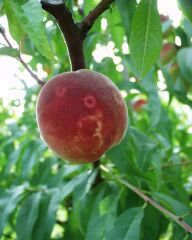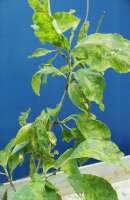|

German Version
Site map
FAIR 3889
Virus diseases
ACLSV
ApMV
ASGV
ASPV
PPV
PDV
PNRSV
ArMV
ToRSV
RpRSV
SLRSV
GFLV
GLRaV-1
GLRaV-3
LChV
CMLV
CRMV
CNRMV
CGRMV
ChTLV
CVA
Phytoplasma diseases
Pathogen collection
Pathogen detection
Pathogen elimination
Contact us
Related Sites
|
Plum Pox Potyvirus
(PPV)
 PPV is the most dangerous viral pathogen of stone fruits, affecting apricot,
peach, nectarine, plum, almond and cherry. Also many wild species can be
infected by the virus. It is transmitted by aphids and therefore extremly
epidemic with a difficult to control spread. The Slavic name for plum pox,
´Sharka´, is the most commonly used name for the disease around
the world.
PPV is the most dangerous viral pathogen of stone fruits, affecting apricot,
peach, nectarine, plum, almond and cherry. Also many wild species can be
infected by the virus. It is transmitted by aphids and therefore extremly
epidemic with a difficult to control spread. The Slavic name for plum pox,
´Sharka´, is the most commonly used name for the disease around
the world.
PPV is known in Europe since the beginning of the 20th century. Since
1950 the spread became more rapid and 1999 it reached Canada and the USA. Estimated
100 million trees are infected in Europe.
Symptoms depend on the cultivar, the age of the plant and the nutrient status.
On leaves light green discolorations and yellow or light green rings may appear.
Fruits develop pigmented rings or line patterns and are often deformed. For plums,
premature fruit fall is abundant. Trees can remain without symptoms for up to 3 years
after infection.
At the moment four major strains of the virus are known, named PPV-D, PPV-M, PPV-C
and PPV-EA, differing in symptom severity and patterns of spread. All strains are
considered as worldwide quarantaine organisms and fast eradication of infected trees
is the most important instrument to control the disease.
Currently, resistance breeding against PPV by transformation of plants with a
viral coat protein gene in investigated at the Institute of Appplied Microbiology
in the frame of a risk
assessment project.
|





